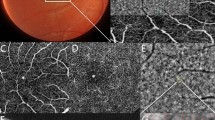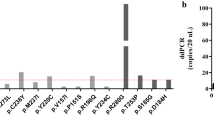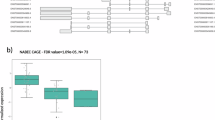Abstract
In this study, we report on a Cameroonian family from the Ewondo ethnic group, presenting with three oculocutaneous albinism type 2 (OCA2) patients homozygous for the 2.7-kb deletion of the P gene. In one of these patients OCA2 was associated with sickle cell anaemia and in two with the sickle cell trait. We took this opportunity to determine single nucleotide polymorphism (SNP) haplotypes within the P gene in this family in comparison with a group of 53 OCA2 patients homozygous for the same mutation and with a matched unrelated full-coloured control group of 49 subjects, originating from seven different ethnic groups of Southern Cameroon including Ewondo. A combination of five exonic and intronic SNPs in the OCA2 gene was genotyped by sequencing PCR products. We found 3 different haplotypes (TAGCT, TAGTT and TAGCC with frequencies of 0.66, 0.28 and 0.06, respectively) associated with the mutation in the 53 OCA2 patients, while 11 different haplotypes were observed in the control group. These observations suggest that the mutation appeared on the relatively frequent haplotype TAGCT, and that the two other haplotypes are derived from two independent recombination events. These haplotypic data, associated with a value of 1/15,000 for the prevalence of the 2.7-kb mutation, a present effective population size of 10,000,000 for Cameroon and a recombination rate of 0.0031, allowed us to estimate that this mutation originated 4,100–5,645 years ago.
Similar content being viewed by others
Log in or create a free account to read this content
Gain free access to this article, as well as selected content from this journal and more on nature.com
or
References
Alexandre P, Binet J (1958) Le groupe dit Pahouin (Fang-Boulou-Beti). Presses Universitaires de France, Paris
Allison AC (1954) Protection afforded by sickle-cell trait against subtertian malareal infection. BMJ 4857:290–294
Aquaron R (1980) L’albinisme oculo-cutané au Cameroun. Rev Epidemiol Santé Publique 28:81–88
Aquaron R (1990) Oculocutaneous albinism in Cameroon: a 15 year follow-up study. Ophthalmic Paediatr Genet 4:255–263
Aquaron R (2000) L’albinisme humain: aspects cliniques, génétiques, cellulaires, biochimiques et moléculaires. Med Trop 60:331–341
Aquaron R, Berge-Lefranc JL (2002) Type 2 oculocutaneous albinism (OCA2) in Cameroon: distribution of the 2.7-kb deletion allele of the P gene among various ethnic groups. Pigment Cell Res 15(Suppl 9):63
Aquaron R, Kamdem L, Menard JC, Bridonneau C, Battaglini PF (1984) Etudes seroanthropologiques des populations albinos et mélanodermes Bamilékés (Cameroun): groupes erythrocytaires ABO et rhésus, hémoglobine S et sensibilité gustative à la phenylthiocarbamide. Med Trop 44:311–318
Austerlitz F, Kalaydjieva L, Heyer E (2003) Detecting population growth, selection and inherited fertility from haplotypic data. Genetics 165:1579–1586
Barbier JC, Nkwi PN (1977) Essai de définition de la chefferie en pays Bamiléké. Grassfield kings and chiefs and modern politics. Documents de l’ Institut des Sciences Humaines, Yaoundé
Barnicot NA (1952) Albinism in south-western Nigeria. Ann Eugen 17:38–73
Chen K, Manga P, Orlow SJ (2002) Pink-eyed dilution protein controls the processing of tyrosinase. Mol Biol Cell 13:1953–1964
Dugast I (1949) Inventaire ethnique du Sud-Cameroun. Mem Inst Franç Afr Noire, Centre du Cameroun, Douala, Cameroun
Durham-Pierre D, Gardner JM, Nakatsu Y, King RA, Francke U, Ching A, Aquaron R, del Marmol V, Brilliant MH (1994) African origin of an intragenic deletion of the P gene in tyrosinase-positive oculocutaneous albinism. Nat Genet 7:176–179
Durham-Pierre D, King RA, Naber JM, Laken S, Brilliant MH (1996) Estimation of carrier frequency of a 2.7-k deletion of the P gene associated with OCA2 in African-Americans. Hum Mutat 7:370–373
Elion J, Berg P, Lapoumeroulie C, Trabuchet G, Mittelman M, Krishnmoorthy R, Schechter A, Labie D (1992) DNA sequence variation in a negative control region 5′ to the β-globin gene correlates with the phenotypic expression of the βS mutation. Blood 79:787–792
Excoffier L, Slatkin M (1995) Maximum-likelihood estimation of molecular haplotype frequencies in a diploid population. Mol Biol Evol 12:921–927
Excoffier L, Laval G, Schneider S (2005) Arlequin ver. 3.0: An integrated software package for population genetics data analysis. Evol Bioinform Online 1:47–50
Gamet A, Labes A (1964) Première étude sur les hémoglobinoses au Centre-Cameroun. Bull Soc Pathol Exot 57:1125–1133
Hedrick PW (2003) Hopi indians, “cultural” selection, and albinism. Am J Phys Anthropol 121:151–156
Ikinciogullari A, Tekin M, Dogu F, Reisli I, Tanir G, Yi Z, Garrison N, Brilliant MH, Babacan E (2005) Meningococcal meningitis and complement component 6 deficiency associated with oculocutaneous albinism. Eur J Pediatr 164:177–179
Imbert J (1973) Le Cameroun. Presses Universitaires de France, Paris
Jannot AS, Meziani R, Bertrand G, Gerard B, Descamps V, Archimbaud A, Picard C, Ollivaud L, Basset-Seguin N, Kerob D, Lanternier G, Lebbe C, Saiag P, Crickx B, Clerget-Darpoux F, Grandchamp B, Soufir N, Melan-Cohort (2005) Allele variations in the OCA2 gene (pink-eyed-dilution locus) are associated with genetic susceptibility to melanoma. Eur J Hum Genet 8:913–920
Juhan I, Kaptué L (1974) Epidémiologie et transfusion sanguine à Yaoundé. Med Afr Noire 21:947–949
Kromberg JGR, Jenkins T (1982) Prevalence of albinism in the South African negro. S Afr Med J 61:383–386
Kwiatkowski DP (2005) How malaria has affected the human genome and what human genetics can teach us about malaria. Am J Hum Genet 77:171–192
Lapoumeroulie C, Dunda O, Ducrocq R, Trabuchet G, Mony-Lobé M, Bodo JM, Carnevale P, Labie D, Elion J, Krishnamoorthy R (1992) A novel sickle cell mutation of yet another origin in Africa: the Cameroon type. Hum Genet 89:333–337
Luande J, Henschke CI, Mohammed N (1985) The Tanzanian human albino skin. Cancer 55:1823–1828
Lund PM (1996) Distribution of oculocutaneous albinism in Zimbabwe. J Med Genet 33:641–644
Mancuso M, Filosto M, Tsujino S, Lamperti C, Shanske S, Coquet M, Desnuelle C, DiMauro S(2003) Muscle glycogenosis and mitochondrial hepatopathy in an infant with mutations in both the myophosphorylase gene and deoxyguanosine kinase genes. Arch Neurol 60:1445–1447
Marguerat Y (1975) Analyse numérique des migrations vers les villes du Cameroun. Documents de l’ORSTOM, Paris
Massie RW, Hartmann RC (1957) Albinism and sicklemia in a negro family. Am J Hum Genet 9:127–132
Myers S, Bottolo L, Freeman C, McVean G, Donnelly P (2005) A fine-scale map of recombination rates and hotspots across the human genome. Science 310:321–324
Nagel RL (2004) Beta-globin-gene haplotypes, mitochondrial DNA, the Y chromosome: their impact on the genetic epidemiology of the major structural hemoglobinopathies. Cell Mol Biol 50:5–21
Nguematcha R, Savina JF, Juhan I, Boche R, Ravisse P (1973) Recherche de la tare drépanocytaire dans un groupe pygmée du Sud Cameroun. Med Afr Noire 20:605–606
Njamnshi AK, Woànkam A, Djientcheu VP, Ongolo-Zogo P, Obama MT, Muna WFT, Sztajzel R (2006) Stroke may appear to be rare in Saudi-Arabian and Nigerian children with sickle cell disease, but not in Cameroonian sickle cell patients. Br J Haematol 133:210
Oettlè AG (1963) Skin cancer in Africa. Natl Cancer Inst (USA) Monograph 10:197–214
Okoro AN (1975) Albinism in Nigeria. Br J Dermatol 92:485–492
Panier J, Mears JG, Dunda-Belkhoya O, Schaefer-Rego KE, Beldjord C, Nagel RL, Labie D (1984) Evidence for the multicentric origin of the sickle cell hemoglobin gene in Africa. Proc Natl Acad Sci USA 81:1771–1773
Puri N, Durham-Pierre D, Aquaron R, Lund PM, King RA, Brilliant MH (1997) Type 2 oculocutaneous albinism (OCA2) in Zimbabwe and Cameroon: distribution of the 2.7-kb deletion allele of the P gene. Hum Genet 100:651–656
Roberts DF, Kromberg JGR, Jenkins T (1986) Differentiation of heterozygotes in recessive albinism. J Med Genet 23:323–327
Rosemblat S, Durham-Pierre D, Gardner JM, Nakatsu Y, Brilliant MH, Orlow SJ (1994) Identification of a melanosomal membrane protein encoded by the pink-eyed dilution (type II oculocutaneous albinism) gene. Proc Natl Acad Sci USA 91:12071–12075
Soodyall H, Vigilant L, Hill AV, Stoneking M, Jenkins T (1996) mtDNA control-region sequence variation suggests multiple independent origin of an “Asian-specific” 9-bp deletion in sub-Saharan Africans. Am J Hum Genet 58:595–608
Spedini G, Destro-Bisol G, Mondovi S, Kaptué L, Taglioli L, Paoli G (1999) The peopling of sub-Saharan Africa; the case study of Cameroon. Am J Phys Anthropol 110:143–162
Spritz RA, Fukai K, Holmes SA, Luande J (1995) Frequent intragenic deletion of the P gene in Tanzanian patients in type II oculocutaneous albinism (OCA2). Am J Hum Genet 56:1320–1323 (1960)
Steinberg MH, Lu ZH, Nagel RL, Venkataramani S, Milner PF, Huey L, Safaya S, Rieder RF (1998) Hematological effects of atypical and Cameroon β-globin gene haplotypes in adult sickle cell anemia. Al J Hematol 59:121–126
Stern C (1960) Principles of human genetics, 2nd edn. Freeman, San Francisco
Stevens G, van Beukering J, Jenkins T, Ramsay M (1995) An intragenic deletion of the P gene is the common mutation causing tyrosinase-positive oculocutaneous albinism in southern African negroids. Am J Hum Genet 56:586–591
Stevens G, Ramsay M, Jenkins T (1997) Oculocutaneous albinism (OCA2) in sub-Saharan Africa: distribution of the common 2.7-kb P gene deletion mutation. Hum Genet 99:523–527
Woolf CM (2005) Albinism (OCA2) in Amerindians. Am J Phys Anthropol Suppl 41:118–140
Yi Z, Garrison N, Cohen-Barak O, Karafet TM, King RA, Erickson RP, Hammer MF, Brilliant MH (2003) A 122.5-kilobase deletion of the P gene underlies the high prevalence of oculocutaneous albinism type 2 in the Navajo population. Am J Hum Genet 72:62–72
Zago MA, Silva WA, Dalle B, Gualandro S, Hutz MH, Lapoumeroulie C, Tavella MH, Araujo AG, Krieger JE, Elion J, Krishnamoorthy R (2000) Atypical βS haplotypes are generated by diverse genetic mechanisms. Am J Hematol 63:79–84
Acknowledgements
We wish to thank all the members of the affected family, the albino patients and the control subjects for their kind cooperation, Pr. P. Ndumbé, dean of the School of Medicine of Yaoundé and Mr. J.J. Ndoudoumou, president of the Cameroonian albino association (ASMODISA) for their continual support, Mr. Luc Kamdem for his skillful assistance, particularly for his help on field trips in Cameroon, Sebastien Courrier for performing HbS and HbA haplotype analysis, Chantal Bideau and Danièlle Iniesta for performing 2.7-kb P gene deletion mutation analysis, Claire Oudin for sequencing OCA2, Pr. Laurent Gouya for helpful discussions, Liane and Sam Lehrer, PhD, Boston Biomedical Research Institute, Boston, for careful reading of the manuscript and Y. Mourayre for graphic assistance.
Author information
Authors and Affiliations
Corresponding author
Rights and permissions
About this article
Cite this article
Aquaron, R., Soufir, N., Bergé-Lefranc, JL. et al. Oculocutaneous albinism type 2 (OCA2) with homozygous 2.7-kb deletion of the P gene and sickle cell disease in a Cameroonian family. Identification of a common TAG haplotype in the mutated P gene. J Hum Genet 52, 771–780 (2007). https://doi.org/10.1007/s10038-007-0181-y
Received:
Accepted:
Published:
Issue date:
DOI: https://doi.org/10.1007/s10038-007-0181-y
Keywords
This article is cited by
-
Co-occurrence of sickle cell disease and oculocutaneous albinism in a Congolese patient: a case report
Journal of Medical Case Reports (2021)
-
Burden of albinism: development and validation of a burden assessment tool
Orphanet Journal of Rare Diseases (2018)



